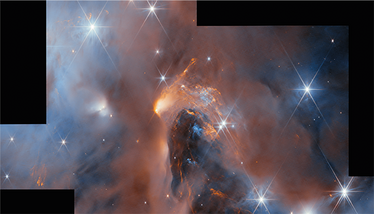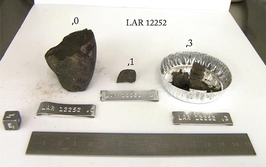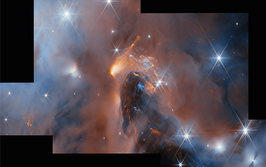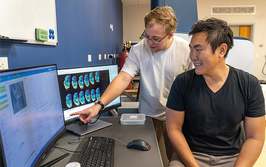Spectroscopy Research Roundup: Krebs Can Form in Interstellar Ice
From the origins of life, to biomolecular monitoring, to endometriosis diagnosis – and more spectroscopy stories
| 6 min read

Credit: Peeking into Perseus (wide field view) (potm2408b) by ESA/Webb, NASA & CSA, A. Scholz, K. Muzic, A. Langeveld, R. Jayawardhana, CC BY 4.0, via Wikimedia Commons
Infrared Spectroscopy Offers New Route to Non-Invasive Endometriosis Diagnosis
Researchers in Brazil have demonstrated a novel infrared (IR) spectroscopy-based method for diagnosing endometriosis from blood plasma samples, offering a potential non-invasive, low-cost alternative to surgical biopsy. The study combines attenuated total reflection Fourier-transform infrared (ATR-FTIR) and near-infrared (NIR) spectroscopy with advanced data fusion and multivariate analysis techniques
Endometriosis, a chronic gynecological condition, is notoriously difficult to diagnose without invasive laparoscopic surgery. Seeking to address this challenge, the team collected blood plasma from 75 women (41 diagnosed with endometriosis, 34 healthy controls) and analyzed the samples using ATR-FTIR and NIR spectroscopy to detect subtle biochemical differences. Data fusion and machine learning algorithms, including principal component analysis combined with support vector machines (PCA-SVM) and genetic algorithms (GA-LDA), were applied to build classification models.
In the mid-infrared region, differences in Amide I and Amide II bands, associated with proteins, were identified as key spectral markers. In the NIR region, differences in combination bands related to water, lipids, and proteins were observed. Notably, when combining the ATR-FTIR and NIR datasets through a data fusion strategy, classification models achieved perfect discrimination between patients and controls, reaching 100 percent accuracy, sensitivity, and specificity. Study link.
ESFG Spectroscopy Sheds Light on OLED Efficiency and Durability
Scientists at Chiba University, Japan, have demonstrated the use of electronic sum-frequency generation (ESFG) spectroscopy to directly probe charge behavior at the buried interfaces of operating organic light-emitting diodes (OLEDs). Their findings provide new insights into the factors that limit OLED efficiency and lifetime.
OLEDs, composed of multiple ultrathin organic layers sandwiched between electrodes, are sensitive to charge accumulation and exciton formation at internal interfaces – processes that can drive degradation over time. Traditional electrical measurements offer indirect clues, but probing these internal phenomena directly has been challenging.
The Chiba team, led by Professor Takayuki Miyamae, employed ESFG spectroscopy, a nonlinear optical technique that is inherently interface-sensitive and non-destructive, to study multilayer OLEDs under operating conditions. By applying voltage and monitoring changes in the ESFG signal, they captured how electric fields and charge accumulation developed across different layers in real time.
The research could accelerate OLED material development by providing a clearer picture of charge transport and emission mechanisms without relying solely on trial-and-error testing. Study link.
Flow-NMR Opens New Window onto Real-Time Biomolecule Kinetics
Researchers have expanded the capabilities of flow-nuclear magnetic resonance (flow-NMR) spectroscopy to enable real-time monitoring of biomolecules, demonstrating the method with a study of liraglutide oligomerization.
Flow-NMR has been widely applied to small molecule reaction monitoring, but its use with biomolecules has been limited by technical challenges such as convection effects and poor solvent suppression. To overcome these, the team developed a novel suite of one-dimensional (1D) and pseudo-two-dimensional (pseudo-2D) proton NMR experiments, including a new flow-compatible diffusion-ordered spectroscopy method, "GUPPY-DOSY," and a transverse relaxation measurement called SOFAIR.
Using this setup, the researchers characterized the pH-dependent oligomerization behavior of liraglutide, a glucagon-like peptide-1 (GLP-1) receptor agonist used in the treatment of type 2 diabetes and obesity. They showed that liraglutide interconverts between two distinct oligomeric states depending on pH, following a two-state transition model. Diffusion coefficients (D) and transverse relaxation rates (R2) were measured in real time, revealing that lower pH favors a larger, more stable oligomeric form, while higher pH promotes smaller oligomers prone to fibrillation.
The study suggests that this expanded flow-NMR methodology could be broadly applied to the analysis of therapeutic proteins, biologics, and other complex systems, offering a new tool for pharmaceutical development and in-line process monitoring. Study link.
The Chemical Basis for Life Can Form in Interstellar Ice
Scientists have synthesized the full suite of organic molecules essential to the Krebs cycle – the metabolic backbone of all respiring life – under simulated conditions of deep space. The research suggests that the chemical precursors to life may have formed in the icy mantles of interstellar dust grains before being delivered to early Earth.
At the Nice Institute of Chemistry (CNRS/Université Côte d’Azur) and the University of Hawaii, researchers recreated conditions found in dense molecular clouds: a temperature of 10 kelvins (-263 °C), deep vacuum, and irradiation with energetic particles simulating cosmic rays. Fine layers of interstellar ice analogues were exposed to ionizing radiation, triggering chemical reactions. Analysis using Fourier-transform infrared (FTIR) spectroscopy tracked chemical changes, while two-dimensional gas chromatography coupled with time-of-flight mass spectrometry (GC×GC–TOF-MS) identified individual carboxylic acids formed.
The study reports the abiotic formation of all nine intermediates of the Krebs cycle. These molecules emerged from simple reactants – methane, carbon dioxide, carbon monoxide, methanol, and water – known constituents of interstellar ices. Study link.
More Spec-tacular Space Stories from The Analytical Scientist
Five Reasons to Be Skeptical About Life on K2-18b
You probably came across the news that scientists have found “the strongest evidence yet of potential life beyond our solar system” – having detected signs of dimethyl sulfide (DMS) and/or dimethyl disulfide (DMDS) in the atmosphere of exoplanet K2-18b using the James Webb Space Telescope (JWST). These compounds, produced primarily by marine microorganisms on Earth, have sparked global excitement about the possibility of life 124 light-years away.
Nikku Madhusudhan who led the research at the University of Cambridge said: “Decades from now, we may look back at this moment as when the living universe came within reach,” Madhusudhan said. “This could be the tipping point, where the question of whether we’re alone in the universe becomes answerable.”
Feeling the hype? Well, here are five reasons to temper your enthusiasm. In short:
- Three-sigma significance isn’t definitive
- Abiotic processes could mimic biosignatures
- Spectral overlap clouds identification
- Complex atmospheric chemistry adds uncertainty
- Data may not show strong spectral features at all
You can read more about the research, and those five reasons, here.
New Findings Challenge Long-Held Theories of Water’s Origin on Earth
Scientists have found evidence that Earth’s building blocks were far richer in hydrogen than previously thought – challenging the dominant theory that Earth's water was delivered later by asteroids. The findings suggest that the formation of habitable conditions on Earth may have been a natural outcome of the planet’s original makeup.
Researchers from the University of Oxford analyzed a meteorite known as LAR 12252, a type of enstatite chondrite thought to closely resemble the material from which Earth formed 4.55 billion years ago. Using sulfur X-ray Absorption Near Edge Structure (S-XANES) spectroscopy at the Diamond Light Source synchrotron, they detected significant quantities of hydrogen intrinsically bonded within the meteorite’s structure.
Co-author Associate Professor James Bryson said: “We now think that the material that built our planet – which we can study using these rare meteorites – was far richer in hydrogen than we thought previously. This finding supports the idea that the formation of water on Earth was a natural process, rather than a fluke of hydrated asteroids bombarding our planet.” Read more.

















